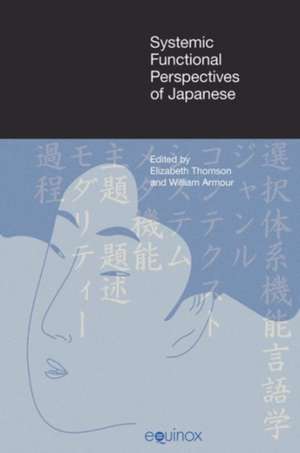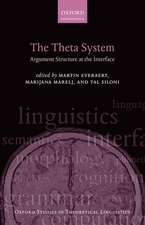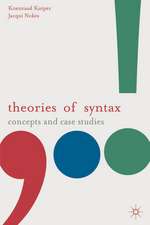Systemic Functional Perspectives of Japanese: Descriptions and Applications: Functional Linguistics
Editat de William Armour, Elizabeth Thomsonen Limba Engleză Hardback – 29 aug 2012
While there have been the occasional chapters on SF treatments of Japanese in monographs, this is the first volume dedicated to Japanese from a systemic functional perspective. The monograph is composed of two parts: Part I descriptions and Part II applications. Part I is further divided into the three metafunctions: textual, interpersonal and ideational.
Part II is divided into applications of the descriptions in Education and in Computing. The Education contributions are a mixture of: work on genres in Japanese and English and applications of SF theory to teaching Japanese as a second/foreign language. The Computing contributions present the application of SF theory to the development of a Japanese language based computer operating system.
The volume also includes a Foreword by Professor Noboru Yamaguchi, Tohoku University, considered to be one of the first linguists to explore systemic-functional perspectives of Japanese.
Din seria Functional Linguistics
-
 Preț: 258.04 lei
Preț: 258.04 lei - 19%
 Preț: 479.70 lei
Preț: 479.70 lei -
 Preț: 230.53 lei
Preț: 230.53 lei -
 Preț: 225.74 lei
Preț: 225.74 lei - 19%
 Preț: 590.75 lei
Preț: 590.75 lei -
 Preț: 182.76 lei
Preț: 182.76 lei -
 Preț: 260.54 lei
Preț: 260.54 lei -
 Preț: 332.07 lei
Preț: 332.07 lei - 19%
 Preț: 568.61 lei
Preț: 568.61 lei -
 Preț: 267.51 lei
Preț: 267.51 lei - 19%
 Preț: 539.43 lei
Preț: 539.43 lei - 19%
 Preț: 559.25 lei
Preț: 559.25 lei -
 Preț: 348.61 lei
Preț: 348.61 lei -
 Preț: 266.52 lei
Preț: 266.52 lei -
 Preț: 260.54 lei
Preț: 260.54 lei -
 Preț: 259.77 lei
Preț: 259.77 lei - 19%
 Preț: 566.28 lei
Preț: 566.28 lei - 19%
 Preț: 602.46 lei
Preț: 602.46 lei
Preț: 567.51 lei
Preț vechi: 700.63 lei
-19% Nou
Puncte Express: 851
Preț estimativ în valută:
108.63€ • 118.03$ • 91.31£
108.63€ • 118.03$ • 91.31£
Carte tipărită la comandă
Livrare economică 21 aprilie-05 mai
Preluare comenzi: 021 569.72.76
Specificații
ISBN-13: 9781845530532
ISBN-10: 1845530535
Pagini: 256
Dimensiuni: 156 x 234 x 31 mm
Greutate: 0.69 kg
Ediția:New.
Editura: Equinox Publishing (Indonesia)
Seria Functional Linguistics
ISBN-10: 1845530535
Pagini: 256
Dimensiuni: 156 x 234 x 31 mm
Greutate: 0.69 kg
Ediția:New.
Editura: Equinox Publishing (Indonesia)
Seria Functional Linguistics
Notă biografică
Elizabeth A. Thomson is the Director of Studies, Defence Force School of Languages, and Research Fellow at the University of New South Wales, Canberra, Australia. She coordinates The Genre Project, an ongoing research initiative aimed at mapping the genres of Japanese, particularly those found in the workplace and in Education. She teaches linguistics, Japanese language and English for Academic Purposes. In 2003 she was awarded the Vice-Chancellor's Award for Outstanding Contribution to Teaching and Learning (Arts) and in 2001 her co-authored CD-ROM, Academic Writing was the winner of the Tertiary Technology Showcase Category in The Australian Awards for Excellence in Educational Publishing. William S. Armour is Senior Lecturer in Japanese Studies at the University of New South Wales, Sydney, Australia. He researches on a variety of topics, including cross-cultural adaptation, how learning an additional language impacts on identity, and manga and anime.
Cuprins
Foreword (Noboru Yamaguchi, Tohoku University) 1. Systemic Functional Theory: Description and Application (Elizabeth Thomson and William Armour) Part I: Description 2. How to Argue in Japanese: A Systemic Functional Interpretation of the Logico-semantic Relations in Japanese Exposition (Motoki Sano and Elizabeth Thomson, University of Wollongong) 3. Description of MOOD in Japanese: Examining Mood Types in a Selected Set of Texts (Nagisa Fukui, University of New South Wales) 4. The System of THEME in Japanese (Elizabeth Thomson) 5. Classifying Natural Phenomena through Language: Lexicogrammatical Resources for Constructing Taxonomies in Japanese Biology Textbooks (Chie Hayakawa, Meijo and Chukyo University) 6. Nominalisation and Nouniness as Meaning Strategies in Japanese Political Manifestos (Kinuko Suto and Christopher Barnard, Teikyo University) Part II: Application 7. Learning How to Mean in Japanese as an Additional Language (William Armour and Reiko Furuya, Nagoya University) 8. Modelling Writing: Using the Genre Approach in the Japanese as a Foreign Language Classroom (Yuko Ramzan and Elizabeth Thomson, University of Wollongong) 9. A Computational Model of Language in Context and its Application to the Understanding of Japanese Text (Noriko Ito, Doshisha University and Toru Sugimoto, Shibaura Institute of Technology) 10. The Components and Structure of the Context Base, a Database for Computer Text Generation (Yusuke Takahashi, Justsystem Corporation, Ichiro Kobayashi, Ochanomizu University, and Michiaki Iwazume, National Institute of Information and Communications Technology)













